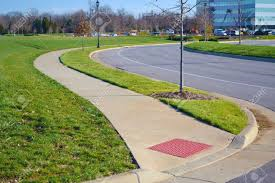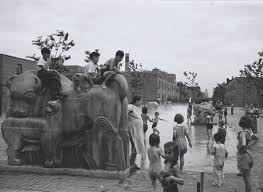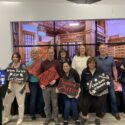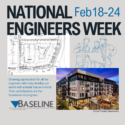Planning Stories of the Day
 “I left my former City position due to a disagreement with the City Manager who told me I could not require public sidewalks (ADA requirement) in a big, downtown project. Public infrastructure for all!” — Andrew Baker, Associate Planner
“I left my former City position due to a disagreement with the City Manager who told me I could not require public sidewalks (ADA requirement) in a big, downtown project. Public infrastructure for all!” — Andrew Baker, Associate Planner
“At the Colorado APA Conference this year, one of the workshops showed how augmented and virtual reality (VR) is now being used as a planning tool. This VR program allowed you to walk through a proposed downtown development and get a good sense of the design and density of a project. This will be a helpful tool to give communities a better visualization and understanding of infrastructure projects.” — Melanie Nieske, Planning Technician
This VR program allowed you to walk through a proposed downtown development and get a good sense of the design and density of a project. This will be a helpful tool to give communities a better visualization and understanding of infrastructure projects.” — Melanie Nieske, Planning Technician
Did You Know…? Jane Addams, Public and Affordable Housing Advocate & First American Woman to Win the Nobel Peace Prize
 Jane Addams was influential in social work as well as how we think about cities today. She opened a women’s boarding house designed to improve the lives of Chicago’s poor and immigrants. This building included Chicago’s first public playground. Jane was an influential figure in city government and encouraged women to become involved with “civic housekeeping” which included activities such as planning, sanitation, and social welfare. She became the first American Woman to win the Nobel Peace Prize.
Jane Addams was influential in social work as well as how we think about cities today. She opened a women’s boarding house designed to improve the lives of Chicago’s poor and immigrants. This building included Chicago’s first public playground. Jane was an influential figure in city government and encouraged women to become involved with “civic housekeeping” which included activities such as planning, sanitation, and social welfare. She became the first American Woman to win the Nobel Peace Prize.
What Makes Community Planning Important? The Planning Process in Stages.
While the planning process has many tentacles and nuances to consider, to simplify, there are basically four steps to a planning process.
- Gather information and data, including maps and statistics. Neighborhood demographics, or the population characteristics are important, such as age, gender, income, ethnicity, etc. You also will need to know what state highway departments and federal agencies might be thinking, and how developers and prospective residents view your community. Find out what the business community thinks of your city and whether it is concentrated in expanding or contracting sectors of the economy. Start thinking early about what maps probably will be necessary to show existing conditions and your future plan. Once you’ve gathered what is likely to be a formidable amount of city planning information, including public attitudes and opinions, you can begin sorting through it to see what is important.
- Analyze existing conditions. Figure out what is interesting, intriguing, problematic, or unusual in your data and information you have gathered. Try to distill what it means. Ask experts what they think and do some research, and rely on your own intimate knowledge of the community as well. Analysis might include projections of existing or desired trends out into the future. Will your town grow? (Of course you think so, but is there any evidence of that, such as a historical trend or a new major employer nearby)? Will your town grow its boundaries and gain control of growth on its edges through annexation? So what will be the population, and the composition of that population, in 20 years?
- Consider city planning alternatives. Start putting together “what if” scenarios. What if we could get rid of that ugly vacant lot in the middle of town? What if we could reconnect Main Street through where that old factory interrupted it? What if we try to bring artists downtown to live and create some 24-hour-a-day presence there? What if we say that all new developments have to be north of the river, because we’re going to keep south of the river as open space? What if we look at our analysis and say that with our blue collared workforce, we have no chance of competing with our neighbors to the north for back-office operations, so we’ll make warehousing our growth industry?
- Decide on the future of your community. Then lastly, make some decisions. You decide collectively as a community if it’s logical to separate residential from commercial land uses–or not. You say we want to double the population, or not. You figure out that you have a competitive advantage economically if you attract even more doctors’ offices or not. Be sure to document these decisions so that everyone can see the plan is inclusive.
Overall, a great plan explains how the recommendations can be implemented, and will provide a roadmap to steer a community in its desired direction.
This week we celebrate our community planners and reflect upon their experience as planners through our “Survey the Planners.” Check out what our planners had to say each day this week for their responses.
- What types of projects do you enjoy most and why?
“Any project that gets built, and after completion you still think is a good project.” —Ben Thurston, AICP, Senior Planner
“I enjoy most getting to help “mom & pop” landowners solve their problems by giving creative solutions to their specific, unique situations. Also, the best projects are those that have an interesting code to crack or a rabbit-hole to go down.” — Ethan Watel, AICP, Planning Manager
“I enjoy projects that involve mid-range planning (~5 years), focused sub-area plans that create urban design and architectural standards. Anything that involves local food systems, environmental justice, or the design of public spaces.”— Andrew Baker, Associate Planner
“I like working on ‘REAL’ projects; soon to be built projects in the current planning/development review process – these usually will get to be ‘seen’ soon.” — Vince Harris, AICP, Director of Planning
“Public engagement projects, getting public feedback.” — Jessie Stonberg, Associate Planner
“Mapping is still my favorite.” — Julie Esterl, Associate Planner
“I enjoy brainstorming concept plans. One of my first projects at Baseline was the Tiny Homes concept plan and I had a lot of fun researching and thinking through the types of unique challenges this community concept would need to address.” — Melanie Nieske, Planning Technician



